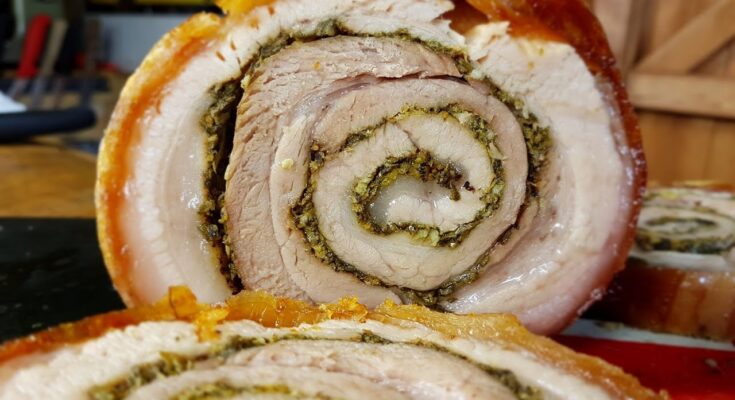Porchetta Recipe: Porchetta is a traditional Italian roast that’s as rich in flavor as it is in history. Known for its crispy, crackling skin and juicy, herb-stuffed interior, porchetta is often the centerpiece of celebratory meals. The word “porchetta” (pronounced por-KET-ta) literally means “little pig” in Italian, referencing the original practice of roasting a whole young pig. Today, however, it’s more common to see this dish made from a boneless pork belly or pork loin, wrapped around aromatic herbs and slow-roasted until tender and golden.
It’s one of those dishes that makes people stop mid-bite and go, “Wow.” Perfectly seasoned meat, wrapped and tied tightly, roasted until the fat renders down and the skin crisps up—it’s truly a meat lover’s dream. And while it may look complicated, you don’t need to be a master chef to make it at home.
Origins of Porchetta in Italian Cuisine
The roots of porchetta go deep into Italian history, especially in the central regions of Lazio, Umbria, and Tuscany. It’s been a street food favorite for centuries, often sold from food trucks at fairs and festivals. In Ariccia, a town near Rome, porchetta is a regional specialty, and locals are fiercely proud of their recipes, each passed down through generations.
Traditionally, it was made during holidays or important family gatherings. It symbolized abundance, celebration, and Italian culinary ingenuity. Over time, its popularity spread not only across Italy but globally. Today, you’ll find porchetta sandwiches in gourmet food trucks and high-end restaurants from New York to Sydney.
Why Porchetta is a Crowd-Pleaser
There’s a reason porchetta never fails to impress. First, it’s all about contrast. You get the crispy, golden crust of the skin, followed by succulent layers of fat and tender meat inside. Then comes the burst of flavor from garlic, rosemary, fennel, and other herbs that infuse the pork from the inside out. Each bite is an explosion of savory, herby goodness.
What also makes porchetta special is its versatility. You can serve it hot with roasted vegetables, cold in sandwiches, or even sliced thin over salads. It’s indulgent but balanced, rustic yet elegant. And because it can be prepped ahead of time, it’s a perfect choice for dinner parties or weekend feasts.
Ingredients You’ll Need
Main Ingredients
To make the perfect porchetta, you’ll need the right ingredients in the right balance. Here’s a basic list to get you started:
- Pork Belly (5 to 6 pounds): Look for a piece with the skin on, evenly layered with fat and meat.
- Salt (Kosher or Sea Salt): Crucial for seasoning the meat and ensuring the skin crisps up.
- Black Pepper: Freshly ground for best flavor.
This trio forms the foundation of your roast, ensuring the meat is seasoned through and the exterior develops that signature crunch.
Herbs and Seasonings
What really sets porchetta apart from other pork roasts is the herbal stuffing. You’ll want to use:
- Fresh Rosemary: Woody and aromatic.
- Fresh Sage: Earthy and slightly peppery.
- Fennel Seeds: Toasted and crushed, for that unmistakable anise kick.
- Garlic (6–8 cloves): Minced or pasted.
- Red Pepper Flakes (optional): For a touch of heat.
- Lemon Zest: Adds brightness and cuts through the richness.
All these herbs work in harmony to give the meat layers of flavor. You’re not just seasoning the surface—you’re building an internal marinade that soaks into the pork as it roasts.
Optional Add-ons for Extra Flavor
Want to elevate your porchetta game? Consider these optional add-ins:
- Pancetta or Prosciutto: Adds another layer of salty, meaty goodness.
- Onion Powder or Shallots: For extra depth of flavor.
- Orange Zest or Juice: A twist of citrus brings a Tuscan flair.
- White Wine or Apple Cider Vinegar (for basting): Adds acidity to balance the fat.
These optional ingredients let you tailor the recipe to your taste or regional preferences. Whether you’re going classic or getting creative, porchetta is forgiving and flavorful.
How to Choose the Right Cut of Pork
Pork Belly vs Pork Shoulder
Choosing between pork belly and pork shoulder depends on the result you’re aiming for.
- Pork Belly is the traditional cut for porchetta. It’s flat, fatty, and perfect for rolling. It crisps up beautifully and keeps the inside moist.
- Pork Shoulder (or pork loin) can also be used. It’s leaner and may need extra fat added to avoid drying out. Often, chefs will wrap pork loin inside pork belly to get the best of both worlds—tender lean meat inside and crispy fat outside.
Tips for Quality Selection
When buying pork, go for high-quality, preferably pasture-raised or heritage breeds. Look for:
- Even marbling
- Firm, pinkish meat
- A generous fat layer
- Skin that’s clean and unblemished
Avoid anything that looks overly pale or smells sour. Your butcher can help you choose a slab that’s uniform in thickness, which makes rolling and cooking much easier.
How Much Meat Per Person?
As a rule of thumb, plan for about 3/4 to 1 pound of raw pork belly per person. Remember, porchetta is rich, and a little goes a long way—especially when served with sides or as a sandwich.
- 4 people: 3–4 lbs
- 6 people: 5–6 lbs
- 8+ people: 8–10 lbs
Better to have leftovers than run out. Porchetta reheats wonderfully and is even delicious cold the next day.
Prepping the Pork for Porchetta
Butterfly Cutting the Pork
To create that classic porchetta roll, you’ll need to butterfly the pork belly—essentially flattening it so you can spread out the herbs and roll it tightly. If you’re using a piece that’s too thick, carefully slice horizontally, being cautious not to cut all the way through.
Lay it out skin side down and use a sharp knife to trim any overly thick layers of fat, but don’t remove too much—you want that flavor and moisture.
Scoring and Seasoning the Meat
Scoring is key. Use a sharp blade to lightly score the flesh in a diamond pattern—this helps the seasoning penetrate deeper. Then, season generously with salt, pepper, and your herb mixture.
Be sure to massage the seasoning well into all the nooks and crannies. Don’t forget to also season the inside edge that will roll inward—it’s easy to miss but important for consistent flavor throughout.
The Secret to Flavorful Marinade
Once seasoned, let the pork rest for at least 12 hours, uncovered in the fridge. This dry brining does wonders:
- Intensifies flavor
- Helps the skin dry out for better crisping
- Firms up the meat for easier rolling
Some even like to place it skin-side up on a rack, allowing air circulation all around. Think of it as the “beauty sleep” before your pork transforms into a golden, crispy porchetta.
Rolling and Tying Your Porchetta
How to Roll the Pork Belly Tightly
Start from one end and roll the belly tightly into a log, like a jelly roll. You want to compress the layers so the herbs and fat hold tight. A loose roll means uneven cooking and lost juices.
Keep the roll firm but not so tight it forces stuffing to squeeze out. A good, snug fit is what you’re aiming for.
Proper Butcher’s Knot Technique
Now comes the fun part: tying. Use butcher’s twine and start at one end, making loops every 1 to 2 inches. Secure it with a classic butcher’s knot. This not only holds the roll together but ensures it roasts evenly and maintains shape.
If you’re unsure about tying, YouTube is full of great visual guides—or just ask your butcher to help pre-tie it for you.
Refrigeration Tips Before Roasting
Once rolled and tied, let your porchetta sit uncovered in the fridge overnight, skin-side up. This air-drying step is essential for achieving that mouthwatering, crackly skin. The drier the skin before it hits the oven, the better the crunch.
Roasting Your Porchetta to Perfection
Oven Temperature and Timing
Now that your porchetta is tightly rolled and rested, it’s time to roast. The secret to perfectly roasted porchetta lies in a two-phase cooking method—slow and low, followed by hot and fast. Start by preheating your oven to 300°F (150°C). This low temperature ensures the meat cooks evenly and the fat slowly renders, keeping everything moist and flavorful.
Roast the porchetta for about 3 to 3.5 hours, depending on the size. A good rule of thumb is 35–40 minutes per pound. Place the roast on a wire rack set in a baking sheet to allow hot air to circulate all around. This promotes even cooking and prevents the bottom from getting soggy.
Once the internal temperature reaches 160°F (71°C), crank the heat up to 475°F (245°C) for the final 20–30 minutes. This blast of heat will crisp up the skin into that irresistible golden crackling. Stay nearby and watch it like a hawk—it can go from crispy to burnt quickly.
How to Check Doneness
The best way to ensure your porchetta is perfectly cooked is by using a meat thermometer. Insert it into the center of the roll, avoiding bones if you included any. You’re aiming for an internal temp of around 180°F (82°C) for a well-rendered, fully cooked porchetta.
Another sign of doneness? When the skin is blistered and golden, and you hear a satisfying crackle when you tap it. Also, check for juices running clear when you pierce it with a knife.
Letting the Meat Rest
Patience is key here. After all that work and roasting, don’t slice it right away. Let your porchetta rest for at least 30 minutes. This allows the juices to redistribute, making for a juicier and more flavorful roast.
Cover loosely with foil and resist the temptation to dig in. This resting period also helps firm up the meat, making it easier to slice cleanly.
Slicing and Serving Porchetta
How to Slice Without Ruining the Skin
Now comes the moment of truth. Place your rested porchetta on a large cutting board and use a sharp serrated knife. Begin slicing into ½-inch thick rounds. You want to maintain the integrity of the crispy skin, so apply firm, even pressure.
If your skin is particularly tough (which it can be when it’s super crisp), you may want to break through it gently with the back of the knife before slicing.
Serve slices immediately, either on a platter as a main dish or tucked inside crusty rolls for the ultimate porchetta sandwich.
Best Side Dishes to Pair With Porchetta
Porchetta is bold and fatty, so pairing it with lighter, acidic, or herbal side dishes helps balance the meal. Here are some ideas:
- Roasted Vegetables: Carrots, fennel, and parsnips caramelize beautifully.
- Crispy Potatoes: Herb-roasted or smashed potatoes work well.
- Simple Green Salad: Arugula with lemon vinaigrette cuts through the richness.
- Grilled Asparagus or Broccolini
- Polenta or Creamy Mashed Potatoes
For sandwiches, try layering slices with sautéed greens, pickled onions, or a smear of mustard or aioli.
Porchetta Variations from Around the World
Regional Italian Twists
Even within Italy, porchetta takes on different personalities. In Ariccia, it’s traditionally flavored with just salt, pepper, and rosemary. In Tuscany, you’ll find wild fennel and garlic taking center stage. Some versions even include pork liver in the stuffing for extra richness.
Each region has its own spin, but they all share the same love for bold, savory pork with crackling skin.
Modern Takes on Porchetta
As porchetta becomes more popular globally, chefs are putting their own modern spins on it. Some cool variations include:
- Porchetta di Pollo (Chicken Porchetta): A lighter version using boneless chicken thighs.
- Beef Porchetta: Rolled beef brisket or short ribs stuffed with Italian herbs.
- Vegan Porchetta: Made with seitan or jackfruit, flavored similarly but 100% plant-based.
Food trucks and gastropubs are also offering porchetta tacos, porchetta burgers, and porchetta ramen—blending cultures while celebrating flavor.
Storing and Reheating Leftovers
How to Properly Store Porchetta
Got leftovers? Lucky you. Store your porchetta in an airtight container in the refrigerator for up to 4 days. You can also wrap it tightly in foil or plastic wrap and freeze it for up to 2 months.
When freezing, consider slicing it first for easier portion control. Wrap individual slices in parchment and stack them in a zip-top freezer bag.
Best Ways to Reheat Without Losing Crisp
To reheat and keep the skin crispy:
- Oven Method (Recommended): Place slices skin-side up on a baking sheet. Bake at 375°F (190°C) for 10–15 minutes.
- Skillet Method: Heat a non-stick pan over medium heat. Place porchetta skin-side down and press lightly to crisp.
- Air Fryer: Reheat at 350°F (175°C) for 5–7 minutes.
Avoid microwaving—it softens the crispy skin and ruins the texture.
Porchetta as a Sandwich Star
Building the Ultimate Porchetta Sandwich
One of the best ways to enjoy porchetta is between two slices of bread. Here’s how to make the ultimate porchetta sandwich:
- Bread: Choose a sturdy roll like ciabatta or sourdough that can hold up to juicy meat.
- Spread: Garlic aioli, Dijon mustard, or even fig jam can complement the pork beautifully.
- Add-ons: Pickled red onions, sautéed broccoli rabe, roasted peppers, or arugula.
- Cheese (Optional): Provolone or fontina melts beautifully with porchetta.
Warm the bread slightly, add your layers, and you’ve got a gourmet sandwich worthy of a five-star food truck.
Serving Ideas for Parties
Porchetta sandwiches are perfect for parties. You can:
- Slice the roast thin and lay it out buffet-style.
- Offer a variety of breads and toppings.
- Let guests build their own sandwiches.
- Pair with craft beers or Italian wines for the ultimate spread.
Whether hot or cold, porchetta sandwiches are guaranteed to wow your guests.
Making Porchetta Ahead of Time
How Far in Advance Can You Prepare It?
Porchetta is the kind of dish that not only holds up well over time but actually improves with a bit of planning. You can prepare it up to 3 days in advance before roasting. In fact, doing so gives the flavors more time to soak into the meat, making each bite richer and more aromatic.
Here’s a simple prep schedule:
- 3 Days Before Serving: Butterfly and season the pork belly. Roll it up and tie it. Store in the fridge, uncovered, to let the skin dry out.
- 1 Day Before Serving: If not done earlier, tie it up and give it a final seasoning touch. Let it continue air-drying in the fridge.
- Day Of: Take it out of the fridge 1 hour before roasting to bring it to room temperature, then roast as planned.
You can also roast it a day ahead and reheat it gently in the oven the next day. Just make sure to re-crisp the skin at high heat before serving.
Freezing for Later Use
If you’re planning ahead for a holiday or big gathering, porchetta freezes beautifully. After assembling the roll, wrap it tightly in cling film and foil, then freeze it raw. When you’re ready to use it, thaw it completely in the refrigerator for 24–48 hours, then roast as directed.
You can also freeze leftover cooked porchetta. Just slice it first, separate layers with parchment paper, and store in an airtight container or freezer bag. Reheat in the oven or air fryer for best texture.
Common Mistakes to Avoid When Making Porchetta
Over or Under Seasoning
One of the biggest pitfalls in making porchetta is not seasoning enough. Remember, this is a thick cut of meat. You need to be generous with salt, pepper, garlic, and herbs—not just on the surface, but in every layer. Skimping here can lead to bland bites.
Conversely, over-salting can dry out the meat. Balance is key. A good tip: use about 1 tablespoon of salt per 5 pounds of pork, adjusting slightly based on preference.
Skipping the Resting Period
Letting porchetta rest before and after cooking is essential. Skipping the pre-roast rest can lead to uneven cooking, and not resting it post-roast causes all the juices to leak out when slicing, leaving you with dry meat.
So, always allow it to:
- Rest uncovered in the fridge before roasting (for crispy skin)
- Rest at room temperature after roasting (for juicy slices)
Not Getting the Skin Crispy
There’s nothing sadder than rubbery pork skin on a porchetta. The culprit? Too much moisture. Always make sure the skin is completely dry before roasting. You can even pat it down with paper towels or leave it uncovered in the fridge overnight.
A final blast of high heat at the end of cooking is what gives you that glorious crackle. If your oven has a broil function, use it carefully to finish off the skin—but watch it closely!
Tips from Italian Nonnas (Grandmas)
Simple is Better
Ask any Italian nonna, and she’ll tell you: the best porchetta comes from simplicity and care, not fancy ingredients. Use fresh herbs, high-quality pork, and don’t go overboard with seasonings. Let the pork and herbs speak for themselves.
Many traditional recipes skip lemon, wine, or hot spices altogether, sticking to garlic, salt, pepper, rosemary, and fennel. That’s the base of a classic porchetta—and it’s stood the test of time for a reason.
Low and Slow is the Way to Go
It’s tempting to rush the roast when you smell all those delicious aromas wafting through your kitchen. But resist. Cooking porchetta low and slow lets the fat render, the meat tenderize, and the skin prep for crisping.
Then, finish it hot—that’s the key rhythm. Think of it like music: slow ballad, then a crescendo of crunch.
Use What You Have
Don’t have pork belly? Use pork shoulder. Can’t find fennel seeds? Use anise or a touch of tarragon. The heart of porchetta is about making do with what’s available and turning it into something comforting, flavorful, and unforgettable.
Porchetta vs. Other Pork Roasts
How Porchetta Differs from Pork Loin or Ham
Porchetta is not your everyday roast. While pork loin is lean and mild, and ham is often cured and smoky, porchetta is rich, layered, and intensely aromatic.
- Texture: Porchetta offers the contrast of crispy skin, juicy fat, and tender meat. Pork loin and ham don’t.
- Flavor: Thanks to the herb stuffing, porchetta is packed with flavor inside and out.
- Presentation: A rolled, spiral cross-section with golden crust—porchetta is visually striking, making it a centerpiece dish.
Why It’s Considered a Gourmet Dish
Though made with simple ingredients, porchetta is often considered gourmet because:
- It takes skill to prepare and roast correctly.
- It has depth of flavor from the herb mix.
- The crispy skin is an art form in itself.
- It’s used in fine dining and street food alike, appealing to all palates.
In the world of pork roasts, porchetta is the rock star—with both grit and glamour.
FAQs about Porchetta Recipe
What is porchetta made of?
Porchetta is traditionally made from a whole, boneless pork belly or pork loin that’s seasoned with herbs like rosemary, fennel, garlic, and black pepper, then rolled and roasted until crispy on the outside and juicy on the inside.
Can I make porchetta with pork shoulder?
Yes, pork shoulder is a great alternative if pork belly or loin isn’t available. It still gives a tender, flavorful result, especially when slow-roasted properly.
How long should I cook porchetta?
Cooking time depends on the size of the meat. Generally, it should roast at a low temperature (around 325°F or 160°C) for 2.5 to 4 hours, followed by a high-heat blast to crisp the skin. Use a meat thermometer to ensure it reaches 145°F (63°C) internally.
How do I get crispy skin on porchetta?
To get that signature crackling, make sure the skin is dry before roasting. Pat it dry, score the skin, and finish with a high-heat roast or broil during the last 15–20 minutes.
Can I prepare porchetta ahead of time?
Absolutely! You can season and roll your porchetta up to 24 hours in advance. Store it in the fridge uncovered to help dry out the skin for an even crispier finish when roasting.
What sides go well with porchetta?
Porchetta pairs perfectly with roasted potatoes, sautéed greens, crusty bread, or even a fresh fennel salad. It’s also amazing in sandwiches!
Is porchetta served hot or cold?
Porchetta is delicious both hot and cold. Serve it hot as a main dish, or slice it thin and serve cold in sandwiches or charcuterie-style.
Conclusion
Porchetta is more than just a roast—it’s a celebration of bold flavor, old-world tradition, and culinary craftsmanship. Whether you’re making it for a weekend feast or a special occasion, following the step-by-step guide ensures you’ll serve up a dish that’s crispy on the outside, tender on the inside, and bursting with herby goodness.
From picking the perfect cut of pork to mastering the roll, seasoning like a pro, and roasting it to perfection, every stage of porchetta is a labor of love. But when you slice into that golden roll and see the swirls of meat, fat, and herbs—every bit of effort is worth it.
So grab your apron, trust the process, and let the pork do the talking. Buon appetito!



